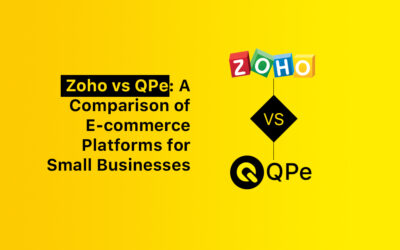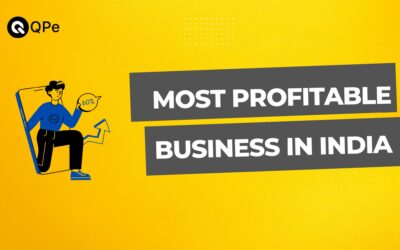E-commerce is no longer an option! With millions of online shops competing for attention, standing out and driving consistent sales can seem impossible. Whether an established retailer or a budding entrepreneur, e-commerce sales require much more than just great products.
The primary challenge? Converting visitors into customers when diversions are just a click away!
At Qpe, you get more than just an e-commerce platform, you get a partner in growth. Our affordable, flexible, and scalable tools are designed to help you stand out, streamline operations, and drive consistent sales.
Ready to take your business to the next level? Let’s build an online store that’s as extraordinary as your brand. Start today with Qpe!
TL;DR – How to Increase E-commerce Sales
In a hurry? Here are the 10 tactics if you want to jump right in:
- Offer Discounts That Actually Work
- Host Seasonal Sales
- Offer Free Shipping
- Run Smart Promotions
- Create a Loyalty Program
- Adjust Your Prices
- Add New Products or Services
- Level Up Your Marketing
- Keep Your Customers Coming Back
- Make Buying Simple
What is E-commerce and How Does it Work?
E-commerce is buying and selling stuff online. Instead of walking into a store, you hop onto a website or app to get what you need. You can shop for clothes, groceries, and gadgets, or even book services like a cleaning crew or a ride.
The best part? It happens anytime, anywhere. Businesses love it because they can reach people all over the world, not just the ones nearby.
Types of E-commerce Models
E-commerce business models can generally be categorized into the following categories.
- Business-to-Business
- Business-to-Consumer
- Consumer-to-Consumer
- Consumer-to-Business
- Business-to-Government
Why Start an E-commerce Business
When you deliver a user-friendly experience, customers are likely to come back for more and help your business build a loyal customer base. Just like this, e-commerce offers numerous advantages to business owners. Some of these are:
-
Zero Overhead
The biggest perk of having an e-commerce website? You save a ton of money. You don’t need to pay for a pricey storefront, rent, or extra staff. That means more cash in your pocket to focus on improving your products or boosting your marketing.
-
Broader Market Reach
E-commerce allows you to connect with customers around the world and not just in your locality. With more shoppers making online purchases, an e-commerce presence and platform can help you increasingly grow your brand and boost sales.
-
Enhanced Customer Insights
With 54.6% of people leaving a brand after one poor experience, understanding your customers is more critical than ever. Features like sentiment analysis, topic extraction, and a real-time dashboard can give you clear insights into what customers care about. You’ll see what they like, what they buy, and how they shop.
-
Flexibility and Agility
In terms of adaptability and efficiency, e-commerce sites significantly surpass traditional retail establishments, which is considered a fundamental advantage of e-commerce. The seller can oversee all operations from the convenience of their home without the need for rented office space.
E-commerce Sales Funnel – How to Optimize for It
An eCommerce sales funnel shows how people go from finding your online store to actually buying something. It’s like a map of the steps they take before they decide to click “buy.”
This helps you figure out where to focus your efforts so more visitors become regular customers.
The stages of a sales funnel include –
-
Awareness
The awareness phase constitutes the most substantial group of individuals positioned at the apex of the sales funnel.
These individuals, who have not yet reached the status of prospects, have recently interacted with your company and its offerings for the first time. At this stage, their familiarity with your brand is minimal, although they are aware of its presence.
-
Consideration
At this phase, some of these newly conscious people may be captivated by the first encounters and be enticed to explore the funnel further.
They will probably take the time to study more about your business and its products now that their interest has been piqued. You can do this by looking through your catalog or website, reading your blog entries, or looking at past client testimonials.
-
Conversion
The objective of the conversion stage is to motivate consumers to buy a product or service, as they perceive the selected brand as the optimal solution to their issue or as fulfilling their requirements.
During this phase, a well-structured product page on the website is crucial, along with providing an outstanding customer service experience to foster consumer confidence in their purchasing choices.
-
Retention
Positive experiences during and after the buying process can significantly impact a shopper’s likelihood of returning as a customer.
In the absence of a strategy to enhance customer loyalty, brands may observe that numerous customers make only a single purchase before moving on.
E-commerce Sales Strategy Components
A good e-commerce sales strategy focuses on steady growth by understanding your market, using smart tech, and keeping your customers happy.
Below is an outline of the key components:
-
E-commerce Growth Goals & KPIs
Set clear KPIs like revenue growth, conversion rates, customer acquisition costs, and average order value.
These tie into bigger goals, like expanding into new markets, grabbing more market share, or boosting brand awareness. Keep an eye on these regularly. It helps you spot trends and figure out what needs fixing.
-
Target Key Sales Channels
Focus on using sales channels that match what your audience needs. Keep your branding, user experience, and messaging consistent across them all. Use tools like Google Analytics to track how each channel performs.
This helps you fine-tune your strategy and invest your time and money where it works best.
-
Customer-Centric Sales Strategy
Understand the pain points, preferences, and buying behavior of your customers through surveys, feedback, and analytics.
According to these, develop customized marketing campaigns, offer flexible payment and shipping options, and provide excellent after-sales support. A fully satisfied customer becomes a loyal advocate.
-
Personalize User Experience
Personalization enhances both customer engagement and conversions. Employ browsing history, purchase patterns, and user demographics to show personalized recommendations, special offers, and relevant content.
This will seamlessly create a personalized shopping experience that may dramatically increase sales and customer satisfaction.
How to Increase E-commerce Sales – 10 Proven Tactics
Running an online store isn’t a walk in the park. It’s tough to stand out when customers have endless options.
But here’s the good news, with a few smart moves, you can boost sales and keep customers coming back.
Let’s dive into some practical tips you can use right away.
1. Offer Discounts That Actually Work
Think about it. Who doesn’t love saving money? Discounts are a great way to nudge customers toward hitting that “Buy Now” button.
Here’s how to do it:
- Create a sense of urgency. For example, “20% off today only.”
- Use tiered discounts. Like, “Buy 2, Get 10% off. Buy 3, Get 15% off.”
- Reward loyal customers with exclusive discounts through email.
Use an exit-intent popup. When someone’s about to leave, offer them a discount to make them rethink.
2. Host Seasonal Sales
Is traffic feeling a little slow? Seasonal sales can give it a serious push.
What works:
- Plan sales around big shopping events like Black Friday or New Year’s.
- Use countdown timers on social media to build excitement.
- Partner with influencers to spread the word.
Don’t forget to make sure your sales pages load fast and look great on mobile.
3. Offer Free Shipping
High shipping costs make people abandon their carts. Solve it by giving them free shipping.
How to pull it off:
- Set a minimum spend, like “Free shipping on orders over $50.”
- Highlight free shipping on your homepage and ads.
- Test it on select products or locations to see what works.
Check your numbers to make sure the extra sales cover your shipping costs.
4. Run Smart Promotions
Promotions aren’t just for getting new customers. They work great for repeat buyers too.
Ideas to try:
- BOGO (Buy One, Get One Free) deals to clear out stock.
- Bundle items that go well together and offer a deal.
- Reward referrals with discounts or freebies.
5. Create a Loyalty Program
Why chase new customers when you can get your current ones to shop again?
How to start:
- Let customers earn points for every dollar they spend.
- Offer perks like early sale access or free samples.
- Send emails reminding them about unused rewards.
Want to make it fun? Add milestones. Customers love unlocking rewards. Do you know the best part? You can create and manage a loyalty program using QPe effortlessly. Contact our team to get started with your online store.
6. Adjust Your Prices
If your profit margins are slim, it’s time to rethink your pricing.
Steps to follow:
- Highlight what makes your product worth the price.
- Introduce premium options for customers who want the best.
- Raise prices slowly and track how your customers react.
Use prices like $49.99 instead of $50. It feels cheaper.
7. Add New Products or Services
Customers get bored if you don’t mix things up. New products can spark fresh interest.
How to do it right:
- Ask your customers what they want. A simple survey works.
- Follow market trends and introduce seasonal items.
- Try pre-orders to see how popular something will be.
Put “New Arrivals” front and center on your site.
8. Level Up Your Marketing
It’s hard to sell if no one knows you exist. Time to fix that.
What to try:
- Run ads on platforms like Google and Facebook.
- Optimize your site for SEO so it ranks higher on search engines.
- Share helpful content like product demos or customer stories.
Retarget cart abandoners with email reminders or ads.
9. Keep Your Customers Coming Back
Getting new customers is expensive. Retaining them is easier—and smarter.
Here’s the plan:
- Send thank-you emails after every purchase.
- Surprise loyal customers with discounts or freebies.
- Ask for reviews and offer rewards for sharing feedback.
Use CRM tools to personalize offers for different groups.
10. Make Buying Simple
Nobody likes a complicated checkout. Make it quick and easy.
How to fix this:
- Offer a guest checkout option.
- Add payment methods people actually use.
- Speed up your site and make it mobile-friendly.
Use trust badges and clear return policies to make customers feel safe.
No magic tricks here. Just practical steps you can take right now. Start small, test what works, and build on it. You’ve got this!
E-commerce Conversion Optimization Techniques
Optimization of conversion rates is essential for achieving success in an extremely competitive e-commerce environment. The adoption of strategic approaches not only draws in customers but also guarantees that they finalize their transactions.
Below are four effective methods for boosting your e-commerce conversion rates:
-
Increase Website Speed & Mobile Optimization
Your website needs to work well on mobile if you want more conversions. Start with a responsive design, faster-loading videos and images, and easy navigation. Don’t forget about the page load speed, it’s huge.
Faster pages mean fewer people leave early and more enjoy shopping, which leads to better conversions.
-
Optimize Customer Journey
A complicated checkout process can irritate a customer which might lead to cart abandonment.
Businesses are therefore advised to reduce the number of steps necessary to finalize a purchase.
Furthermore, it is important to design the checkout process to be intuitive and user-friendly and incorporate a clear progress indicator.
-
Retarget Abandoned Carts
It is essential to address abandoned shopping carts rather than allowing them to remain unutilized.
Engage these prospective customers through follow-up emails or targeted advertisements.
A strategically timed reminder, potentially accompanied by a discount or a free shipping incentive can encourage visitors to revisit and finalize their transactions.
-
A/B Test Product
A/B testing lets you test different versions of your site to see what clicks with your audience.
Try out various headlines, images, and calls to action. It helps you figure out what works best to boost conversions.
Essential Ecommerce Tools for Growth and Efficiency
The selection of appropriate ecommerce tools can significantly impact your success. Given the multitude of options available, selection can be challenging. So, here are some of the tools that can guarantee to elevate your business to new heights.
-
QPE
QPe is your go-to e-commerce platform for any business, no matter the size. It makes running your store easier, keeps customers happy, and helps you grow without the stress.
Let’s talk about what it does:
- Upload products in bulk.
- Handle multiple stores without breaking a sweat. Always know what’s in stock with real-time inventory updates.
- Get your store noticed with built-in SEO tools. Run retargeting ads, set up loyalty programs, and use email campaigns to keep customers coming back.
- Sell anywhere. QPe supports multiple currencies and languages, so you’re ready for international customers.
- Get clear reports on sales and customer habits. Use that data to make smarter decisions.
- Connect QPe to CRMs, payment systems, and other tools you already use.
- Whether you’re selling to other businesses or straight to customers, QPe’s got you covered.
- Plans that won’t drain your wallet. And yes, they stack up well against pricier options like Shopify.
QPe isn’t just another platform. It’s the tool to help your business grow and thrive.
-
Google Analytics
A go-to tool for e-commerce businesses, Google Analytics can help you understand your platform’s performance. Its enhanced e-commerce feature lets you dive deep into your data and can help you track user activity throughout the entire sales funnel.
Google Analytics helps by identifying the origin of your website traffic and the reason behind visitors turning into customers. It also helps in discovering which pages keep visitors engaged the longest which can help businesses to optimize their performance and improve their user experience.
-
Optimizely
With Optimizely’s Web Experimentation tool, you can use a no-code editor which can help you set up A/B tests and fine-tune your content easily. It also lets you analyze customer data to help you identify what works best for you.
Along with this, you can also experiment with chatbots and checkout flows to reduce cart abandonment. The Full Stack tool lets you roll out new features quickly which further helps you in staying ahead of your competitors.
-
QuickBooks
QuickBooks specializes in helping you stay organized, save time, and make informed financial decisions by simplifying your inventory tracking system and tax calculations.
Frequently Asked Questions (FAQs)
-
Is E-commerce Dead in 2024, or Is It Still Growing?
E-commerce is far from dead in 2024; it continues to thrive. Global sales are projected to exceed $6.3 trillion with an 8.76% hike from the previous year. This growth trend is expected to persist, driven by increasing mobile shopping and changing consumer preferences for online purchasing.
-
How Do I Improve Conversion Rates on My E-commerce Site?
The key factors to improve e-commerce conversion rates include speeding up a website and making it mobile-friendly. Display calls-to-action; back this up with dazzling images to evoke desire among users. Showcase customer testimonials to build trust in your brand and make checking out as seamless as possible along with adding more payment methods.
-
How Can Personalization Impact E-commerce Sales Growth?
Personalized shopping enhances user experience motivating customers to finalize purchases, revisit your store, and develop a fondness for your brand. Additionally, it fosters greater customer loyalty, as individuals prefer businesses that offer unique, tailored experiences.
Conclusion
E-commerce is a multi-faceted process to enhance e-commerce sales, whereby you understand your audience, optimize the sales funnel, and effectively use technology in the process. By taking these actions, an e-commerce company can position itself for long-term success and maximize customer satisfaction.
Ready to take your e-commerce business to the next level? With Qpe, you’ll have access to powerful tools, scalable solutions, and seamless integration, all designed to optimize your growth and maintain operational efficiency.
Start today and position your e-commerce business for sustained success because, with Qpe, growth is just the beginning.



